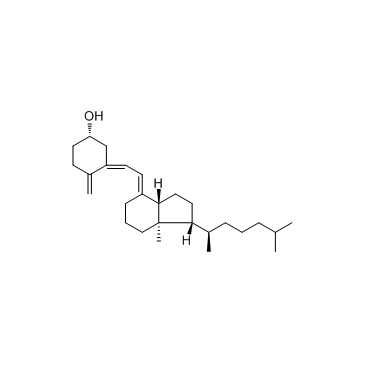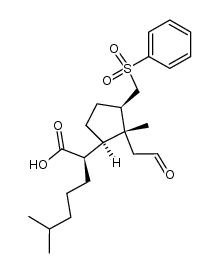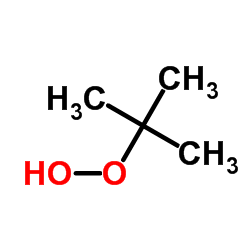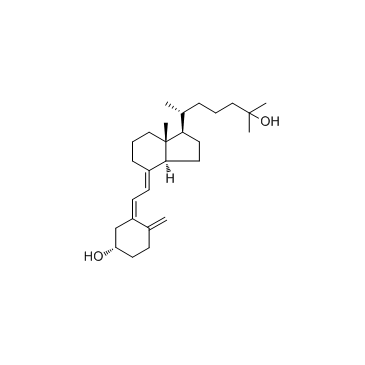Vitamin D3

Vitamin D3 structure
|
Common Name | Vitamin D3 | ||
|---|---|---|---|---|
| CAS Number | 67-97-0 | Molecular Weight | 384.638 | |
| Density | 1.0±0.1 g/cm3 | Boiling Point | 496.4±24.0 °C at 760 mmHg | |
| Molecular Formula | C27H44O | Melting Point | 83-86 °C(lit.) | |
| MSDS | Chinese USA | Flash Point | 214.2±15.1 °C | |
| Symbol |


GHS06, GHS08 |
Signal Word | Danger | |
Use of Vitamin D3Cholecalciferol(Vitamin D3) is a naturally occuring form of vitamin D; Reported that upon metabolic activation, Cholecalciferol induces cell differentiation and prevents proliferation of cancer cells. IC50 value:Target: Vitamin D acts through a receptor that is a member of the ligand-dependent transcription factor superfamily. Modulates the proliferation and differentiation of both normal and cancer cells. Has antiproliferative and antimetastatic effects on breast, colon, and prostate cancer cells. Activated vitamin D receptors in intestine and bone maintain calcium absorbance and homeostasis. |
| Name | calciol |
|---|---|
| Synonym | More Synonyms |
| Description | Cholecalciferol(Vitamin D3) is a naturally occuring form of vitamin D; Reported that upon metabolic activation, Cholecalciferol induces cell differentiation and prevents proliferation of cancer cells. IC50 value:Target: Vitamin D acts through a receptor that is a member of the ligand-dependent transcription factor superfamily. Modulates the proliferation and differentiation of both normal and cancer cells. Has antiproliferative and antimetastatic effects on breast, colon, and prostate cancer cells. Activated vitamin D receptors in intestine and bone maintain calcium absorbance and homeostasis. |
|---|---|
| Related Catalog | |
| Target |
Human Endogenous Metabolite |
| References |
| Density | 1.0±0.1 g/cm3 |
|---|---|
| Boiling Point | 496.4±24.0 °C at 760 mmHg |
| Melting Point | 83-86 °C(lit.) |
| Molecular Formula | C27H44O |
| Molecular Weight | 384.638 |
| Flash Point | 214.2±15.1 °C |
| Exact Mass | 384.339203 |
| PSA | 20.23000 |
| LogP | 9.72 |
| Vapour Pressure | 0.0±2.9 mmHg at 25°C |
| Index of Refraction | 1.523 |
| Storage condition | 2~8°C |
Synonym:Cholecalciferol; 9,10-Secocholesta-5,7,10(19)-trien-33-o Section 2 - COMPOSITION, INFORMATION ON INGREDIENTS
Risk Phrases: 25 Section 3 - HAZARDS IDENTIFICATION EMERGENCY OVERVIEW
Toxic if swallowed.Light sensitive. Potential Health Effects Eye: May cause eye irritation. Skin: May cause skin irritation. Ingestion: May be fatal if swallowed. May cause irritation of the digestive tract. May cause kidney damage. May cause cardiac disturbances. Ingestion may lead to mental retardation. Inhalation: May cause respiratory tract irritation. Chronic: Chronic ingestion may cause effects similar to those of acute ingestion. Section 4 - FIRST AID MEASURES Eyes: Immediately flush eyes with plenty of water for at least 15 minutes, occasionally lifting the upper and lower eyelids. Get medical aid. Skin: Get medical aid if irritation develops or persists. Flush skin with plenty of soap and water. Ingestion: If victim is conscious and alert, give 2-4 cupfuls of milk or water. Never give anything by mouth to an unconscious person. Get medical aid. Inhalation: Remove from exposure and move to fresh air immediately. Get medical aid if cough or other symptoms appear. Notes to Physician: Section 5 - FIRE FIGHTING MEASURES General Information: As in any fire, wear a self-contained breathing apparatus in pressure-demand, MSHA/NIOSH (approved or equivalent), and full protective gear. Extinguishing Media: In case of fire, use water, dry chemical, chemical foam, or alcohol-resistant foam. Section 6 - ACCIDENTAL RELEASE MEASURES General Information: Use proper personal protective equipment as indicated in Section 8. Spills/Leaks: Sweep up or absorb material, then place into a suitable clean, dry, closed container for disposal. Avoid generating dusty conditions. Section 7 - HANDLING and STORAGE Handling: Wash thoroughly after handling. Use with adequate ventilation. Minimize dust generation and accumulation. Avoid contact with eyes, skin, and clothing. Keep container tightly closed. Do not ingest or inhale. Storage: Store in a cool, dry, well-ventilated area away from incompatible substances. Store protected from light and air. Section 8 - EXPOSURE CONTROLS, PERSONAL PROTECTION Engineering Controls: Use adequate general or local exhaust ventilation to keep airborne concentrations below the permissible exposure limits. Exposure Limits CAS# 67-97-0: Personal Protective Equipment Eyes: Wear appropriate protective eyeglasses or chemical safety goggles as described by OSHA's eye and face protection regulations in 29 CFR 1910.133 or European Standard EN166. Skin: Wear appropriate protective gloves to prevent skin exposure. Clothing: Wear appropriate protective clothing to prevent skin exposure. Respirators: Follow the OSHA respirator regulations found in 29 CFR 1910.134 or European Standard EN 149. Use a NIOSH/MSHA or European Standard EN 149 approved respirator if exposure limits are exceeded or if irritation or other symptoms are experienced. Section 9 - PHYSICAL AND CHEMICAL PROPERTIES Physical State: Solid Color: white Odor: none reported pH: Not available. Vapor Pressure: Not available. Viscosity: Not available. Boiling Point: Not available. Freezing/Melting Point: 84-85C Autoignition Temperature: Not available. Flash Point: Not available. Explosion Limits, lower: Not available. Explosion Limits, upper: Not available. Decomposition Temperature: Solubility in water: Insoluble. Specific Gravity/Density: Molecular Formula: C27H44O Molecular Weight: 384.64 Section 10 - STABILITY AND REACTIVITY Chemical Stability: Stable under normal temperatures and pressures. Conditions to Avoid: Incompatible materials, light, dust generation, exposure to air. Incompatibilities with Other Materials: Strong oxidizing agents - acid chlorides - acid anhydrides. Hazardous Decomposition Products: Carbon monoxide, carbon dioxide. Hazardous Polymerization: Has not been reported. Section 11 - TOXICOLOGICAL INFORMATION RTECS#: CAS# 67-97-0: VS2900000 LD50/LC50: CAS# 67-97-0: Oral, mouse: LD50 = 42500 ug/kg; Oral, rat: LD50 = 42 mg/kg. Carcinogenicity: Vitamin D3 - Not listed by ACGIH, IARC, or NTP. Other: See actual entry in RTECS for complete information. Section 12 - ECOLOGICAL INFORMATION Section 13 - DISPOSAL CONSIDERATIONS Dispose of in a manner consistent with federal, state, and local regulations. Section 14 - TRANSPORT INFORMATION IATA Shipping Name: TOXIC SOLID, ORGANIC, N.O.S.* Hazard Class: 6.1 UN Number: 2811 Packing Group: II IMO Shipping Name: TOXIC SOLID, ORGANIC, N.O.S. Hazard Class: 6.1 UN Number: 2811 Packing Group: II RID/ADR Shipping Name: TOXIC SOLID, ORGANIC, N.O.S. Hazard Class: 6.1 UN Number: 2811 Packing group: II Section 15 - REGULATORY INFORMATION European/International Regulations European Labeling in Accordance with EC Directives Hazard Symbols: T Risk Phrases: R 25 Toxic if swallowed. Safety Phrases: S 24/25 Avoid contact with skin and eyes. WGK (Water Danger/Protection) CAS# 67-97-0: 1 Canada CAS# 67-97-0 is listed on Canada's DSL List. CAS# 67-97-0 is not listed on Canada's Ingredient Disclosure List. US FEDERAL TSCA CAS# 67-97-0 is listed on the TSCA inventory. SECTION 16 - ADDITIONAL INFORMATION N/A |
CHEMICAL IDENTIFICATION
HEALTH HAZARD DATAACUTE TOXICITY DATA
|
| Symbol |


GHS06, GHS08 |
|---|---|
| Signal Word | Danger |
| Hazard Statements | H301 + H311-H330-H372 |
| Precautionary Statements | P260-P280-P284-P301 + P310-P310 |
| Personal Protective Equipment | Eyeshields;Faceshields;Gloves;type P2 (EN 143) respirator cartridges |
| Hazard Codes | T+:Verytoxic; |
| Risk Phrases | R24/25;R26;R48/25 |
| Safety Phrases | S28-S36/37-S45-S28A |
| RIDADR | UN 2811 6.1/PG 2 |
| WGK Germany | 2 |
| RTECS | VS2900000 |
| Packaging Group | II |
| Hazard Class | 6.1 |
| HS Code | 2936240000 |
| HS Code | 2936240000 |
|---|
|
Effect of concentrate feeder design on performance, eating and animal behavior, welfare, ruminal health, and carcass quality in Holstein bulls fed high-concentrate diets.
J. Anim. Sci. 93 , 3018-33, (2015) A total of 240 Holstein bulls (121 ± 2.0 kg initial BW; 99 ± 1.0 d of age), from 2 consecutive fattening cycles, were randomly allocated in 1 of 6 pens and assigned to 1 of the 3 treatments consisting... |
|
|
Cheminformatics analysis of assertions mined from literature that describe drug-induced liver injury in different species.
Chem. Res. Toxicol. 23 , 171-83, (2010) Drug-induced liver injury is one of the main causes of drug attrition. The ability to predict the liver effects of drug candidates from their chemical structures is critical to help guide experimental... |
|
|
Translating clinical findings into knowledge in drug safety evaluation--drug induced liver injury prediction system (DILIps).
J. Sci. Ind. Res. 65(10) , 808, (2006) Drug-induced liver injury (DILI) is a significant concern in drug development due to the poor concordance between preclinical and clinical findings of liver toxicity. We hypothesized that the DILI typ... |
| Oxarol |
| Vitamin D3 |
| Ebivit |
| Cholecalciferolum |
| (3S,5Z,7E)-9,10-Secocholesta-5,7,10-trien-3-ol |
| (1S,3Z)-3-[(2E)-2-{(1R,3aS,7aR)-1-[(1R)-1,5-Dimethylhexyl]-7a-methyloctahydro-4H-inden-4-yliden}ethyliden]-4-methylidencyclohexanol |
| Cyclohexanol, 3-[(2E)-2-[(1R,3aS,7aR)-1-[(1R)-1,5-dimethylhexyl]octahydro-7a-methyl-4H-inden-4-ylidene]ethylidene]-4-methylene-, (1S,3Z)- |
| Micro-Dee |
| (5Z,7E)-(3S)-9,10-secocholesta-5,7,10(19)-trien-3-ol |
| Deparal |
| FeraCol |
| MFCD00078131 |
| 9,10-secocholesta-5,7,10-trien-3-ol, (3S,5Z,7E)- |
| Prezios |
| cholecalciferol |
| (1S,3Z)-3-[(2E)-2-[(1R,3aS,7aR)-1-[(1R)-1,5-dimethylhexyl]octahydro-7a-methyl-4H-inden-4-ylidene]ethylidene]-4-methylenecyclohexanol |
| UNII-1C6V77QF41 |
| Vi-De3 |
| MC 1275 |
| Granuvit D3 |
| Devaron |
| (3b,5Z,7E)-9,10-Secocholesta-5,7,10(19)-trien-3-ol |
| cyclohexanol, 3-[(2E)-2-[(1R,3aS,7aR)-1-(1,5-dimethylhexyl)octahydro-7a-methyl-4H-inden-4-ylidene]ethylidene]-4-methylene-, (1S,3Z)- |
| rampage |
| vitamin D3 powder |
| D3-Vicotrat |
| NEO Dohyfral D3 |
| (1S,3Z)-3-[(2E)-2-{(1R,3aS,7aR)-1-[(1R)-1,5-dimethylhexyl]-7a-methyloctahydro-4H-inden-4-ylidene}ethylidene]-4-methylidenecyclohexanol |
| Vigantol |
| EINECS 200-673-2 |
| 9,10-Secocholesta-5,7,10(19)-trien-3-ol, (3β,5Z,7E)- |
| (1S,3Z)-4-Methylene-3-[(2E)-2-{(1R,3aS,7aR)-7a-methyl-1-[(2R)-6-methyl-2-heptanyl]octahydro-4H-inden-4-ylidene}ethylidene]cyclohexanol |
| colecalciferol |
| Videkhol |
| (3β,Z,7E)-9,10-Secocholesta-5,7,10(19)-trien-3-ol |
| [3H]-Vitamin D3 |
| 9,10-Secocholesta-5,7,10(19)-trien-3b-ol |
| calciol |
| Provitina |
| VITAMIN D |
 CAS#:98854-76-3
CAS#:98854-76-3 CAS#:105764-33-8
CAS#:105764-33-8 CAS#:75-91-2
CAS#:75-91-2 CAS#:13403-10-6
CAS#:13403-10-6![tert-Butyl-{3-[2-(diphenyl-phosphinoyl)-ethylidene]-4-methylene-cyclohexyloxy}-dimethyl-silane structure](https://image.chemsrc.com/caspic/214/100858-27-3.png) CAS#:100858-27-3
CAS#:100858-27-3![{[(3Z)-3-(2-Chloroethylidene)-4-methylenecyclohexyl]oxy}(dimethyl )(2-methyl-2-propanyl)silane structure](https://image.chemsrc.com/caspic/289/138313-18-5.png) CAS#:138313-18-5
CAS#:138313-18-5 CAS#:19356-17-3
CAS#:19356-17-3
